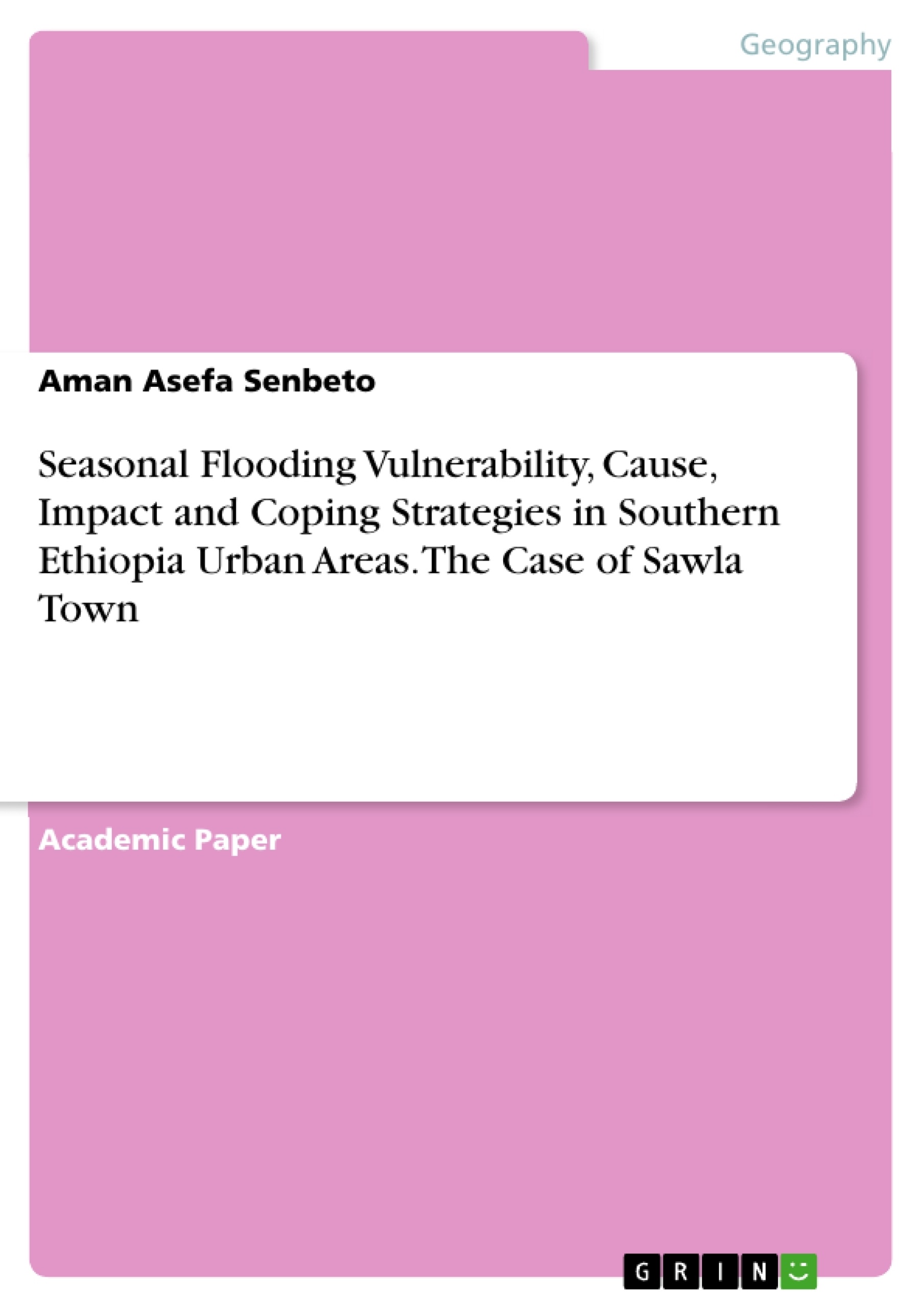Sawla town is geographically inscribed by the chains of mountain range from south to west, and from west to north. And the main town is dissected by two crossing rivers namely, ‘Womba and Cholea’. Due to increasing demographic dynamics of the town accompanied by rapid urbanization, demand of land for housing is higher than that of the available recognized land under the municipal authority; hence informal settlement patterns are becoming the usual trend especially towards ecologically sensitive boundaries of the town which is characterized by mountain hill sides, sloppy forest land and gully structures and the two river plains. As a result of deforestation and impermeable coverings by construction, the capacity of the natural land feature to infiltrate and percolate rain precipitation is decreasing from time to time with the subsequent increase in surface runoff conveyed to water bodies across drainages and urban storm ways. This trend of increase in surface runoff is featuring Sawla town by seasonal flooding calamity with a serious social, economic and environmental impact especially encountered by poor vulnerable communities. Therefore the purpose of this study is to assess seasonal flooding vulnerability, cause and impact in Sawla town by then suggesting feasible recommendation to mitigate the impact of seasonal flooding on the social, economic and environmental wellbeing of the town. A descriptive research type was employed to describe the cause and impacts of seasonal flooding on vulnerable communities of the town. Reliable data have been gathered from 163 (93% response rate) randomly selected respondents founded from four kebeles (Zirko, Botre, Kera and Kusti) of the town through questionnaire, interview and observation. Based on the data obtained from the field and secondary data sets, urbanization and informal settlement, deforestation, rainfall variability as climatic change and inadequacy of infrastructure are identified causes of seasonal flooding in the town. This seasonal flooding trend produced serious social, economic and environmental damages in Sawla town.
Table of Contents
- Chapter One
- 1.1 Introduction
- 1.2 Background
- 1.3 Statement of the Problem
- 1.4 Research Objectives
- 1.4.1 General Objective
- 1.4.2 Specific Objectives of the Study
- 1.5 Research Questions
- 1.6 Significance of the study
- 1.7 Scope of the study
- 1.8 Description of the study area
- 1.8.1 Location
- 1.8.2 Demographic Data
- Chapter Two
- 2.1 Introduction
- 2.2 Definitions and Concepts of Flooding
- 2.3 Causes of Flooding in Urban Areas
- 2.3.1 Urbanization
- 2.3.2 Deforestation
- 2.3.3 Climate Change
- 2.4 Vulnerability of People to Floods
- 2.4.1 A Vulnerability Framework
- 2.5 Flooding and its Impact
- 2.5.1 Economic Impact of Flooding
- 2.5.2 Social Impacts
- 2.5.3 Environmental Impact
- 2.6 Coping Strategies
- 2.7 Aspects of Flood in Urban Context
- 2.8 Flood Management
- 2.8.1Management of Urban Drainage
- 2.9 Flood Vulnerability, Impact and Coping Strategies in International Perspective
- 2.9.1. Flooding Impact and Coping Strategy in Scotland
- 2.9.2 Flooding Impact and Coping Strategy in Korail, Dhaka
- 2.9.3. Flood Impact and Proactive Measures in Mumbai, India
- 2.10 Flood Disaster Profile of Ethiopia
- 2.10.1 Policies and Institutional Frameworks Related to Disaster In Ethiopia
- Chapter Three
- 3.1 Introduction
- 3.2 Research approach
- 3.3 Research Methods
- 3.3.1 Research techniques and instrumentations
- 3.4 Sampling design
- 3.4.1 Population
- 3.4.2 Sampling Frame
- 3.4.3 Sampling Unit
- 3.4.4 Sampling techniques
- 3.4.5 Sample Size
- 3.4.6 Sample
- 3.5 Source of Data
- 3.6 Data Analysis and Interpretations
- 3.7 Data presentation
- 3.8 Limitations of the study
- 3.9 Conclusion
- Chapter Four
- 4.1 Introduction
- 4.2 Socio-economic Data of Respondents
- 4.3.3 Result and Finding
- 4.3.1 Vulnerability of People to Seasonal Flooding in Sawla Town
- 4.3.2 Causes of Seasonal Flooding in Sawla Town
- 4.3.3 Impacts of Seasonal Flooding in Sawla Town
- 4.3.4 Coping Strategies and Adaptations to Flooding in Sawla Town
- 4.4 Interpretation and Discussion
- 4.4.1 Vulnerability of People to Seasonal Flooding in Sawla Town
- 4.4.2 Causes of Seasonal Flooding in Sawla Town
- 4.4.3 Impacts of Seasonal Flooding in Sawla Town
- 4.4.4 Coping strategies to adapt seasonal flooding in Sawla town
- 4.5 Conclusion
- Chapter Five
- 5.1 Introduction
- 5.2 Conclusions
- 5.3 Recommendations
Objectives and Key Themes
This thesis aims to assess the vulnerability, causes, and impacts of seasonal flooding in Sawla Town, Southern Ethiopia, and to suggest recommendations for mitigating these impacts on the social, economic, and environmental well-being of the town.
- Urbanization and informal settlements
- Deforestation and environmental degradation
- Climate change and rainfall variability
- Vulnerability of residents to flood risk
- Social, economic, and environmental impacts of seasonal flooding
Chapter Summaries
- Chapter One: Introduces the study's context, background information on flooding, the statement of the problem, research objectives, and the scope of the study area. It also provides a detailed description of Sawla Town, including its location and demographic data.
- Chapter Two: Presents a comprehensive literature review on the concepts of urban flooding, causes, impacts, and coping strategies. It examines international perspectives on flood vulnerability, impact, and coping strategies, and analyzes the flood disaster profile and relevant policies and institutional frameworks in Ethiopia.
- Chapter Three: Outlines the research methods employed in the study, including the research approach, data collection techniques, sampling design, data analysis, and data presentation. It also discusses the limitations of the study.
- Chapter Four: Presents the findings of the study, analyzing the vulnerability of residents to seasonal flooding, the causes of flooding, the social, economic, and environmental impacts, and the coping strategies adopted by the community.
Keywords
This research focuses on seasonal flooding, urban vulnerability, deforestation, urbanization, climate change, rainfall variability, social impacts, economic impacts, environmental impacts, coping strategies, and flood management in the context of Sawla Town, Southern Ethiopia.
- Quote paper
- Aman Asefa Senbeto (Author), 2012, Seasonal Flooding Vulnerability, Cause, Impact and Coping Strategies in Southern Ethiopia Urban Areas. The Case of Sawla Town, Munich, GRIN Verlag, https://www.grin.com/document/449070



